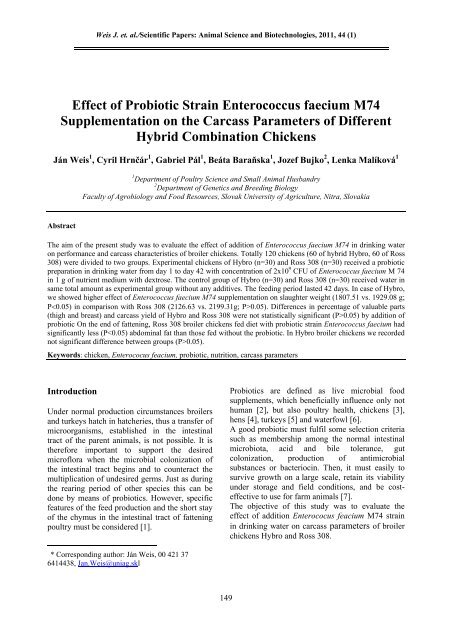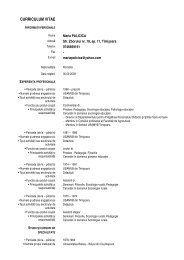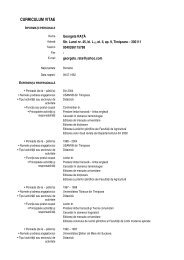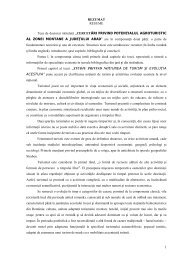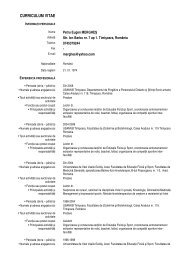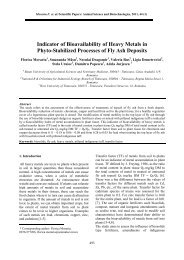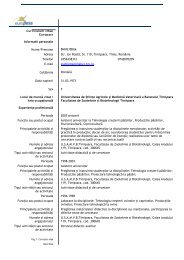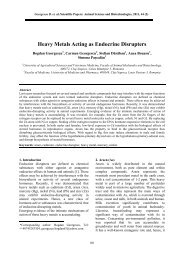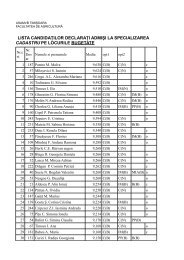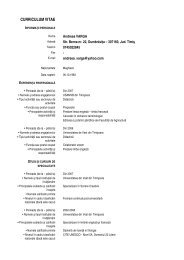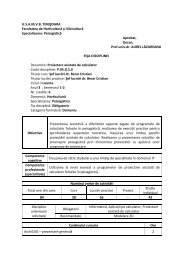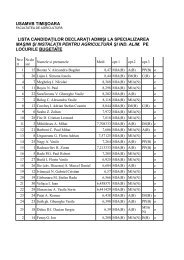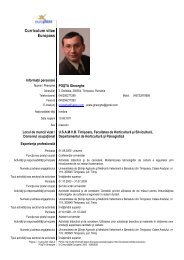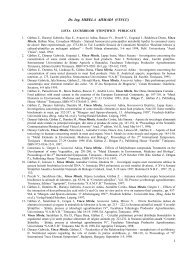Effect of Probiotic Strain Enterococcus faecium M74 ...
Effect of Probiotic Strain Enterococcus faecium M74 ...
Effect of Probiotic Strain Enterococcus faecium M74 ...
Create successful ePaper yourself
Turn your PDF publications into a flip-book with our unique Google optimized e-Paper software.
Weis J. et. al./Scientific Papers: Animal Science and Biotechnologies, 2011, 44 (1)<strong>Effect</strong> <strong>of</strong> <strong>Probiotic</strong> <strong>Strain</strong> <strong>Enterococcus</strong> <strong>faecium</strong> <strong>M74</strong>Supplementation on the Carcass Parameters <strong>of</strong> DifferentHybrid Combination ChickensJán Weis 1 , Cyril Hrnčár 1 , Gabriel Pál 1 , Beáta Baraňska 1 , Jozef Bujko 2 , Lenka Malíková 11 Department <strong>of</strong> Poultry Science and Small Animal Husbandry2 Department <strong>of</strong> Genetics and Breeding BiologyFaculty <strong>of</strong> Agrobiology and Food Resources, Slovak University <strong>of</strong> Agriculture, Nitra, SlovakiaAbstractThe aim <strong>of</strong> the present study was to evaluate the effect <strong>of</strong> addition <strong>of</strong> <strong>Enterococcus</strong> <strong>faecium</strong> <strong>M74</strong> in drinking wateron performance and carcass characteristics <strong>of</strong> broiler chickens. Totally 120 chickens (60 <strong>of</strong> hybrid Hybro, 60 <strong>of</strong> Ross308) were divided to two groups. Experimental chickens <strong>of</strong> Hybro (n=30) and Ross 308 (n=30) received a probioticpreparation in drinking water from day 1 to day 42 with concentration <strong>of</strong> 2x10 9 CFU <strong>of</strong> <strong>Enterococcus</strong> <strong>faecium</strong> M 74in 1 g <strong>of</strong> nutrient medium with dextrose. The control group <strong>of</strong> Hybro (n=30) and Ross 308 (n=30) received water insame total amount as experimental group without any additives. The feeding period lasted 42 days. In case <strong>of</strong> Hybro,we showed higher effect <strong>of</strong> <strong>Enterococcus</strong> <strong>faecium</strong> <strong>M74</strong> supplementation on slaughter weight (1807.51 vs. 1929.08 g;P0.05) in comparison with Ross 308 (2126.63 vs. 2199.31g; P>0.05). Differences in percentage <strong>of</strong> valuable parts(thigh and breast) and carcass yield <strong>of</strong> Hybro and Ross 308 were not statistically significant (P>0.05) by addition <strong>of</strong>probiotic On the end <strong>of</strong> fattening, Ross 308 broiler chickens fed diet with probiotic strain <strong>Enterococcus</strong> <strong>faecium</strong> hadsignificantly less (P0.05).Keywords: chicken, Enterococus feacium, probiotic, nutrition, carcass parametersIntroductionUnder normal production circumstances broilersand turkeys hatch in hatcheries, thus a transfer <strong>of</strong>microorganisms, established in the intestinaltract <strong>of</strong> the parent animals, is not possible. It istherefore important to support the desiredmicr<strong>of</strong>lora when the microbial colonization <strong>of</strong>the intestinal tract begins and to counteract themultiplication <strong>of</strong> undesired germs. Just as duringthe rearing period <strong>of</strong> other species this can bedone by means <strong>of</strong> probiotics. However, specificfeatures <strong>of</strong> the feed production and the short stay<strong>of</strong> the chymus in the intestinal tract <strong>of</strong> fatteningpoultry must be considered [1].<strong>Probiotic</strong>s are defined as live microbial foodsupplements, which beneficially influence only nothuman [2], but also poultry health, chickens [3],hens [4], turkeys [5] and waterfowl [6].A good probiotic must fulfil some selection criteriasuch as membership among the normal intestinalmicrobiota, acid and bile tolerance, gutcolonization, production <strong>of</strong> antimicrobialsubstances or bacteriocin. Then, it must easily tosurvive growth on a large scale, retain its viabilityunder storage and field conditions, and be costeffectiveto use for farm animals [7].The objective <strong>of</strong> this study was to evaluate theeffect <strong>of</strong> addition Enterococus feacium <strong>M74</strong> strainin drinking water on carcass parameters <strong>of</strong> broilerchickens Hybro and Ross 308. * Corresponding author: Ján Weis, 00 421 376414438, Jan.Weis@uniag.skl149
Weis J. et. al./Scientific Papers: Animal Science and Biotechnologies, 2011, 44 (1)2. Material and methodsThe experiment was realised in half-operationconditions <strong>of</strong> experimental basis <strong>of</strong> Department<strong>of</strong> Poultry Science and Small Animal Husbandry(Certificate <strong>of</strong> Authorization to Experiment onLiving Animals, State Veterinary and FoodInstitute <strong>of</strong> Slovak Republic, no. SK PC 30008).Totally 120 chickens (60 <strong>of</strong> hybrid Hybro, 60 <strong>of</strong>Ross 308) were divided to two groups.Experimental chickens <strong>of</strong> Hybro (n=30) andRoss 308 (n=30) received a probiotic preparationProtexin Pr<strong>of</strong>essional (<strong>Probiotic</strong>s International, UK)in drinking water from day 1 to day 42 withconcentration <strong>of</strong> 2x10 9 CFU <strong>of</strong> <strong>Enterococcus</strong><strong>faecium</strong> M 74 in 1 g <strong>of</strong> nutrient medium withdextrose (1% in preparation). Quantization <strong>of</strong>drinking water and probiotic preparate are presentedin Table 1. The control group <strong>of</strong> Hybro (n=30) andRoss 308 (n=30) received water in same totalamount as experimental group without anyadditives.Table 1. Dosage <strong>of</strong> drinking water and probiotic strain in experimental groupsWeek <strong>of</strong>fatteningTotal amount <strong>of</strong> drinkingwater per day (l)Dose <strong>of</strong> probioticpreparate (g)CFU in 1 ml <strong>of</strong>drinking water1. 2.50 5.04 4.03x10 62. 3.50 2.10 1.20x10 63. 4.60 2.10 9.13x10 54. 6.70 2.10 6.27x10 55. 8.60 2.10 4.88x10 56. 10.60 2.10 3.96x10 5The feeding period lasted 42 days. Two types <strong>of</strong>complete feed mixtures (Boskop, a.s., Trenčín,Slovak Republic) have been distributed accordingto periods <strong>of</strong> fattening: HYD–01 (d1–d21) inpowdery form and HYD–02 (d22–d42) in granularform, both no inclusions <strong>of</strong> anticoccidials.Nutritional value <strong>of</strong> diets is shown in Table 2.Feeding was provided on an ad libitum basis fromcontainers on the front <strong>of</strong> the cages.Table 2. Nutritional value <strong>of</strong> complete feed mixturesNutritient Unit HYD–01 HYD–02Crude protein g/kg min. 210 min. 190ME MJ/kg min. 12 min. 12Lysine g/kg min. 11 min. 9.5Methionine and cistine g/kg min. 7.5 min. 7.5– from that methionine g/kg min. 4.5 min. 4Linoleic acid g/kg min. 10 min. 10Calcium g/kg min. 8 min. 7Phosphorus g/kg min. 6 min. 5Sodium g/kg 1.2–3.0 1.2–2.5Manganese mg/kg min. 50 min. 50Iron mg/kg min. 60 min. 60Copper mg/kg min. 6 min. 6Zinc mg/kg min. 50 min. 50Vitamin A i.u./kg min. 10000 min. 8000Vitamin B2 mg/kg min. 4 min. 3Vitamin B12 μg/kg min. 20 min. 20Vitamin D3 i.u./kg min. 1200 min. 1200Vitamin E mg/kg min. 15 min. 15Birds were stabled in a 3-etage cage technology(MBD, Czech Republic) consisted <strong>of</strong> 18 cageswith proportions 75x50 cm (0.375 m 2 ).At the end <strong>of</strong> the experiment, 10 broiler chickens<strong>of</strong> similar body weight to the group average wereselected from each group, weighted and killed bysevering <strong>of</strong> the bronchial vein. The weights <strong>of</strong>carcass, breast, thigh and abdominal fat wererecorded individually. The research data analyseswere made by the usual variation statistics methodsand Student’s t-test was used to compare means.150
Weis J. et. al./Scientific Papers: Animal Science and Biotechnologies, 2011, 44 (1)(P


